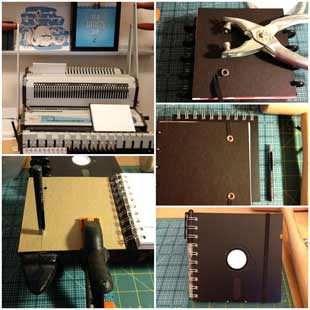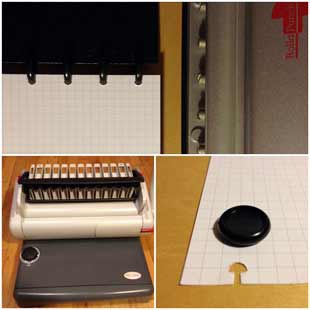This is a guide for binding your own sketchbooks. I offer it to you designers, developers, makers, and tinkerers out there who are looking for a way to physically connect to your practice of designing interfaces, or who maybe just want a fun and practical way to get your hands dirty.
Enjoy! -Michael
I started making my own sketchbooks and pads a few years ago. At the time there weren't many options for interface sketching and storyboarding.
I began buying different types of notebooks, researching simple bookbinding, taking classes, and prototyping. I wound up liking wirebound books best. You can see pictures of some of the notebooks I made and some of the interface design sketchbooks I later sold via this site and Amazon.
The project to sell the sketchbooks was a great learning experience—one I would highly recommend. I wanted to go through the steps of learning to design something physical, figure out how to get it produced, and learn about the logistics of selling and fulfilling.
It was a great experience, and a lot of people put up with the progressive quality improvements in each phase.
After a few years making and selling my sketchbooks, I stopped. I've had many requests to stock them again, but in the end the time and effort to devote to this business of designing and selling atoms, and improving the product costs more to me than I have to give. I've decided to just tell you how I make mine and give you the printable sheets, links to resources, and the steps to make your own.
The easiest method for binding your own sketchbooks would be to take paper (either plain white, or printable graphpaper) to your local copy shop and have them wirebind your pages together. The suggestions below might help if you want to invest in a binding machine and do it yourself like I do.
Equipment
I use a wire binding machine to do all of my own personal sketchbooks, using the double-ring style binding closure, also called wire-o or twin-loop. I prefer this style of binding because it lays flat, and the cover can be folded back on itself to make it easy to keep a small book on your lap or desk.
The machine in the pictures on the top right of this page is the Akiles Wiremac Duo. It's not inexpensive, but it gave me the most flexibility when it came to binding both large and small books. It's a heavy machine with a 16" x 17" footprint, but it's made to work hard and last a long time. I've bound hundreds of books with this one and it still works like new.
At the lowest end is a an inexpensive little craft product called the Bind it All, a mini-wirebound books, but you can also shift the paper along the binder to bind bigger books. Seems like a time consuming chore, but people like it for little craft projects, so I assume it might work for smaller wire bound books too.
Planning
Decide on the kind of sketchbook you're going to make. Here are some things to figure out.
- What size? Letter (8.5" x 11"), half letter (8.5" x 5.5"), A5?
- What orientation? Portrait bound on the long side or landscape bound on the short?
- How many pages? Number of pages determines the coil size to buy.
- Elastic enclosure? If yes, you'll need a way to attach them.
- Envelope or pocket in the back? If you use eyelets to attach, they'll interfere with the back pages. Envelopes or pockets prevent this from happening. Envelopes are easier because they can be bound with the back cover. Pockets need to be glued on.
Materials
Shop around. There may be more affordable sources out there than what I've used.
- Heavy stock/chipboard for front and back cover. MyBinding sells them in letter size.
- Paper (blank, graphpaper, whatever)
- Wire-O coils
- Envelope or Pocket stock (optional)
- 1/4" elastic, eyelets, eyelet puncher, wooden mallet, anvil, eyelet closing tool (optional)
I got my binding materials from the ProBinding and My Binding sites. The Eyelets and hardware for snap closures came from Seattle Fabrics. The elastic came from Create for Less.
Binding
This tutorial shows you exactly how I bind books with the wire-binding machine. What you end up doing will depend on the machine you choose, but the steps should be about the same.
1. Measure

Measure stack of paper, front cover and back cover against the binder's coil guide. This will tell you what size coil to use. I typically create 50-60 page notebooks with a 3/4" 2:1 coil.
2. Hang your coils

Hang your coils on the coil holder on the front of the binder.
3. Punch envelope

Punch envelope first and place with front of envelope facing forward.
4. Punch paper

Punch paper in sets and place on coils, repeat until all placed.
5. Punch front cover

Punch front cover and place on coils, with front of cover facing forward.
6. Punch back cover

Punch back cover and place on coils, with inside facing forward.
7. Cut coils

Cut coils to end of book edge.
8. Pull the stack and close coil

Pull the stack off of the binder, and rest with open coil side down on the coil squeezer. Pull lever to close coils.
9. Flip over and enjoy

Flip over the back cover. You'll notice that because you hung the envelope and paper first, the inwardly-turned part of the coil should keep paper from sliding out of the rings.
Attaching elastic closure (optional)
1. Punch back cover

Create a cardboard rig to place your eyelets evenly on the back and use a clamp or bulldog clips to hold the cover and jig together. Use your punch and mallet to punch two holes at the corners about 1" in from each side. The wooden mallet works well with a small anvil.
2. Insert cut elastic and eyelet

Cut 1/4" elastic bands. Measure so that they'll be snug around the front. I measure to the length of the edge of book that will be wrapped and add 2-3 inches for the books above. Thread the elastic through your holes and leave 1/2" hanging on the inside. Push the eyelets through the holes, outside facing the back.
3. Close eyelets and you're done!

Use your eyelet crimping tool to snap closed the open end and fasten the elastic to the back cover. Make sure you're using the right end of the eyelet tool or else they won't close properly and cleanly. You can now cut that excess 1/2" of elastic from the inside back cover.
Rolla/Circa/Atoma Binding
The big costly binders aren't your only option. In the image at right are pics of books I've bound with a DIY disk-binding system. They have sort of a cult following among notebook and journal obsessives because of their versatility.
Disk systems let you punch small mushroom shaped holes in your paper that you slide into disks (some people call these Smurf binders because of the shape). This lets you easily remove and replace pages in your books. Nice, right?
There are a few vendors that sell disk binding systems. The ones I'm familiar with are shown at right.
Sketchpads
Sketchpads are made by gluing stacks of paper that on one end. To make sketchpads, you'll need a padding press, paper, chipboard, and padding compound. These are easily obtained from office and binding supply stores.
Tim Liston pointed me to an inexpensive wooden binder called the Pad Magic Paper Padding Press that looks decent for DIYers doing small runs. The free printable graphpaper sheets on this site are perfect for this.


